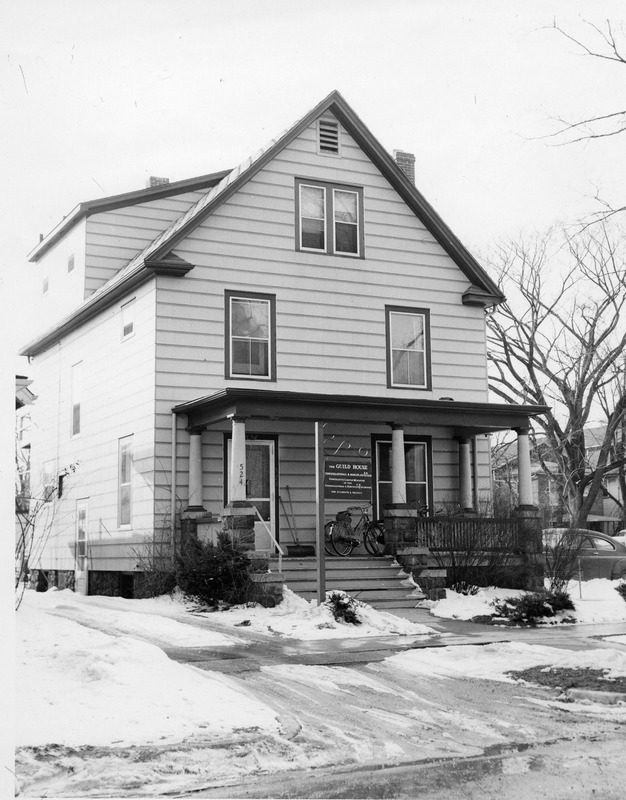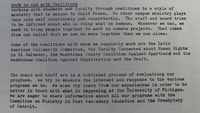The Guild House: A Meeting Place for Activists
Some of the roots of the anti-apartheid movement at the University of Michigan came from Christian tradition. This trend occurred internationally and a prominent example could be Reverend Sullivan’s Principles, which became an essential part of the divestment debate within the United States. In Ann Arbor, one of the largest social organizers was the Guild House. The Guild House was established in 1892 and provided an important role in various social movements at the campus, including involvement in the anti-Vietnam War Movement, the Black Action Movement (BAM), and the anti-apartheid movement. The mission statement calls for concern of a just and humane society, acknowledging that it never held a neutral position, “Like all people and institutions we are not neutral; we stand with those who struggle for human justice and decency.”
Guild House focused on promoting positive social values and that extended to being concerned with what was occurring at the University, “Rooted in a University community of students, faculty, staff, campus labor, and administrators, Guild House is committed to raising questions that make explicit the values which guide the policies and practices of the University.” Over the years, the Guild House served as a hub for various progressive student groups. For example, the Michigan African Student Union began to use the House for its headquarters around 1959. According to a 2015 interview with Heidi Gottfried, she and Rachel Rosenberg, another student, formed the People’s Action Coalition (PAC) at the Guild House in the spring of 1976. The PAC was devoted to transforming campus. Gottfried described the organization as being an “umbrella organization” that looked at various social issues that were happening on campus. They had a call out for members to join. The PAC later evolved and served as a basis for the WCCAA.
Heidi Gottfried, a founding member of the Washtenaw County Coalition Against Apartheid, recalls in a 2015 interview how the Coalition was formed,
So the Guild House was, in fact, the sort of location that brought us together. And I’d say probably the campus ministers had some in the front because the church in South Africa at the time were very much involved in the anti-Apartheid movement on all sides. And Revered Sullivan. . . who wrote the Sullivan Principles. . . The church was very critical of Apartheid, they were very involved in the anti-Apartheid movement but as the church always is, as any institution, there were many different currents. The campus ministry Guild House were very left wing—very left wing. And so, they were very critical of the Sullivan Principles. So there was a meeting with people from the Black Student Coalition, People’s Action Coalition, and probably other organizations. . . and we talked about having an organization, an anti-Apartheid organization, and one thing I do remember, very, very vividly and clearly was that it shouldn’t be a student organization. That is, it should make, maybe it could be based in the University or at the University but it must be the Washtenaw County Coalition in Washtenaw County. We see ourselves being broad based—a coalition that is beyond the University community. We were very, very clear about that. People’s Action Coalition, we were very student-oriented,student focused. The Washtenaw County Coalition Against Apartheid group was in our name, to encompass our principles and goals it must be a wide ranging and inclusive organization that reflects the large community and it did. Now many of our activities, because we were students, took place at the University, were at the University, but we were always hopefully and we always reached out to other organizations in the Washtenaw County.
With a strong focus on non-violence and education, the Guild House provided several different speakers series to engage the university community. Gottfried mentioned that faculty were an essential part of mobilizing the students involved at the Guild House around important social movements. The Michigan Daily ran a series of advertisements for noon luncheons during the late 1970s through the mid 1980s that brought various speakers to talk about social issues. Some of the notable speakers involved Joel Samoff on “Academic Freedom and Radical Faculty,” a panel from the PAC on “The Resurgence of Radicalism on Campus,” State Representative Perry Bullard on “South Africa, The Draft, and Students,” as well as speakers on “The Origins of the Ann Arbor Anti-War Movement,” homosexuality, and feminism. It truly was a hub for discussion and education for liberal students on campus which lends itself to being the location of groups like the WCCAA.
Part of the success of the Guild House involved the guidance provided by the clergy and affiliated members. Their presence in Ann Arbor over the course of several movements allowed them to continue legacies even as students graduated from the university and moved away. In a statement before the Civil Rights Committee on November 27th, 1979, Reverend A. Donald Coleman, then the co-director of the Guild House, used strong language to argue that not only are apartheid practices immoral but that the church needed to pull any of its investments in South Africa. “Moral arguments and pressures alone will not change South Africa. Political and economic pressure will make a difference. We need not only have the right but the duty to refuse to continue empowering a racist nation like South Africa. We must divest ourselves and our institutions of investments that support and profit from business in South Africa.” The Guild House engaged state and national institutions with its own agenda, even when not directly working with their affiliated students.
Sources for this page:
"Guild House Mission Statement, " Administration-Executive Board- Staff Reports, Box 9, Guild House records 1924-2005(bulk 1940-1990): Activities, Bentley Historical Library, University of Michigan.
The Guild House, Staff Report, n.d. Early 1980s, Don and Ann Marie Coleman files (1975-1991), Topical (and other office files),Committee Ministry in the Secondary Education Request for Funding, 1983, Box 7, Guild House records 1924-2005(bulk 1940-1990), Bentley Historical Library, University of Michigan.
Interview of Heidi Gottfried by Emily Bodden and Aaron Szulczewski, April 9, 2015, Ann Arbor, MI.
Statement by Rev. A. Donald Coleman, Co-Director of Guild House- A United Campus Ministry, Hearings before the Civil Rights Committee , November 27, 1979, Box 25, Perry Bullard Papers, Bentley Historical Library, University of Michigan.




